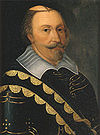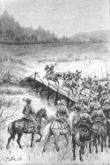
Polish-Swedish union
Encyclopedia




Personal union
A personal union is the combination by which two or more different states have the same monarch while their boundaries, their laws and their interests remain distinct. It should not be confused with a federation which is internationally considered a single state...
between the Polish–Lithuanian Commonwealth, and the Kingdom of Sweden, when Sigismund III Vasa
Sigismund III Vasa
Sigismund III Vasa was King of Poland and Grand Duke of Lithuania, a monarch of the united Polish–Lithuanian Commonwealth from 1587 to 1632, and King of Sweden from 1592 until he was deposed in 1599...
, King of Poland, was crowned King of Sweden in 1592. In 1599, after a civil war, he lost this crown and returned to Warsaw
Warsaw
Warsaw is the capital and largest city of Poland. It is located on the Vistula River, roughly from the Baltic Sea and from the Carpathian Mountains. Its population in 2010 was estimated at 1,716,855 residents with a greater metropolitan area of 2,631,902 residents, making Warsaw the 10th most...
.
Prelude
After the death of John III of SwedenJohn III of Sweden
-Family:John married his first wife, Catherine Jagellonica of Poland , house of Jagiello, in Vilnius on 4 October 1562. In Sweden, she is known as Katarina Jagellonica. She was the sister of king Sigismund II Augustus of Poland...
, his son Sigismund
Sigismund III Vasa
Sigismund III Vasa was King of Poland and Grand Duke of Lithuania, a monarch of the united Polish–Lithuanian Commonwealth from 1587 to 1632, and King of Sweden from 1592 until he was deposed in 1599...
became heir to the throne of Sweden. Sigismund at that time was already the elected King of Poland (since 1587). Sigismund certainly valued the Swedish throne and upon learning about the death of his father, and the pretensions to the throne of his uncle, Duke Charles of Södermanland
Charles IX of Sweden
Charles IX of Sweden also Carl, was King of Sweden from 1604 until his death. He was the youngest son of King Gustav I of Sweden and his second wife, Margaret Leijonhufvud, brother of Eric XIV and John III of Sweden, and uncle of Sigismund III Vasa king of both Sweden and Poland...
, he asked the Sejm
Sejm
The Sejm is the lower house of the Polish parliament. The Sejm is made up of 460 deputies, or Poseł in Polish . It is elected by universal ballot and is presided over by a speaker called the Marshal of the Sejm ....
(Polish parliament) for permission to leave the Commonwealth and go to Sweden, where he could secure the Swedish crown. The Sejm gave him permission, and on 3 August 1593, Sigismund, accompanied by his wife, Anna of Habsburg
Anna of Habsburg
Anne of Austria was queen consort of Poland and Sweden by marriage to Sigismund III Vasa, king of Poland and Sweden.-Biography:Anne was a daughter of Charles II of Austria and Maria Anna of Bavaria...
, and other followers, departed for Sweden.
In Sweden, he encountered a serious problem due to his religion, as Sigismund was a devoted Catholic
Roman Catholic Church
The Catholic Church, also known as the Roman Catholic Church, is the world's largest Christian church, with over a billion members. Led by the Pope, it defines its mission as spreading the gospel of Jesus Christ, administering the sacraments and exercising charity...
, and most of the Swedish population (including Charles) had converted to Lutheranism
Lutheranism
Lutheranism is a major branch of Western Christianity that identifies with the theology of Martin Luther, a German reformer. Luther's efforts to reform the theology and practice of the church launched the Protestant Reformation...
. There were fears that Sigismund, if elected king, would support the Catholics against the Protestants. At this period Duke Charles and his Protestant friends were clearly outnumbered by the supporters of Sigismund. Nevertheless, immediately after King John’s death, a synod
Synod
A synod historically is a council of a church, usually convened to decide an issue of doctrine, administration or application. In modern usage, the word often refers to the governing body of a particular church, whether its members are meeting or not...
summoned to Uppsala
Uppsala
- Economy :Today Uppsala is well established in medical research and recognized for its leading position in biotechnology.*Abbott Medical Optics *GE Healthcare*Pfizer *Phadia, an offshoot of Pharmacia*Fresenius*Q-Med...
by Duke Charles rejected the new liturgy and drew up an anti-Catholic confession of faith, March 5, 1593. Holy Scripture and the three primitive creeds were declared to be the true foundations of Christian faith, and the Augsburg confession
Augsburg Confession
The Augsburg Confession, also known as the "Augustana" from its Latin name, Confessio Augustana, is the primary confession of faith of the Lutheran Church and one of the most important documents of the Lutheran reformation...
was adopted, on January 9, 1594, in Uppsala
Uppsala
- Economy :Today Uppsala is well established in medical research and recognized for its leading position in biotechnology.*Abbott Medical Optics *GE Healthcare*Pfizer *Phadia, an offshoot of Pharmacia*Fresenius*Q-Med...
. Sigismund was confronted by the representatives of the Lutherans and the lower nobility
Nobility
Nobility is a social class which possesses more acknowledged privileges or eminence than members of most other classes in a society, membership therein typically being hereditary. The privileges associated with nobility may constitute substantial advantages over or relative to non-nobles, or may be...
. Pressured by the political situation, and amidst the turmoil which included Sigusmund's Catholic entourage and their Lutherans opponents, he eventually agreed on February 19, to guarantee religious freedom to the Protestants, and forbade the Catholics from public demonstrations of their faith and from holding high offices.
The union
The agreement of 19 February seemed to have calmed the situation; Sigismund was crowned in the Cathedral of Uppsala and became the king of Sweden. The Kingdom of Sweden was now in a personal unionPersonal union
A personal union is the combination by which two or more different states have the same monarch while their boundaries, their laws and their interests remain distinct. It should not be confused with a federation which is internationally considered a single state...
with Poland-Lithuania. In July, Sigismund left Sweden in the hands of the regency council and returned to Poland. Sweden was to be ruled jointly by the Privy Council of Sweden
Privy Council of Sweden
The High Council of Sweden or Council of the Realm consisted originally of those men of noble, common and clergical background, that the king saw fit for advisory service...
and Sigismund's uncle Duke Charles.
Sigismund, however, reneged on his earlier promises, opening Catholic schools, and giving Catholics prominent posts. Charles in turn did not give up on acquiring the Swedish throne and pursued his own political agenda. On 18 May 1595 he signed a treaty of Tiavzin with Muscovy, ending the Russo-Swedish War (1590–1595) by giving up part of Finland
Finland
Finland , officially the Republic of Finland, is a Nordic country situated in the Fennoscandian region of Northern Europe. It is bordered by Sweden in the west, Norway in the north and Russia in the east, while Estonia lies to its south across the Gulf of Finland.Around 5.4 million people reside...
(Keksholm) and recalling some of Sigismund's supporters their posts (among them, Admiral Klaus Fleming
Klaus Fleming
Baron Clas Eriksson Fleming was a Finnish-born member of the Swedish nobility and admiral, who played an important role in Finnish and Swedish history during the rise of Sweden as a Great Power...
). That went against Sigismund plans, as he has promised in his pacta conventa
Pacta conventa
Pacta conventa may mean:*Pacta conventa , a contractual agreement between the Polish nobility and king, in force from 1573 to 1764*Pacta conventa , a contractual agreement between the Croatian nobility and the Hungarian king, in force from 1102 to 1918...
during his election to the Commwealth throne to return Livonia
Livonia
Livonia is a historic region along the eastern shores of the Baltic Sea. It was once the land of the Finnic Livonians inhabiting the principal ancient Livonian County Metsepole with its center at Turaida...
to the Commonwealth from Sweden, and in turn compensate Sweden with territory acquired from Muscovy. In 1595, Charles openly disobeyed the king by calling the Riksdag
Parliament of Sweden
The Riksdag is the national legislative assembly of Sweden. The riksdag is a unicameral assembly with 349 members , who are elected on a proportional basis to serve fixed terms of four years...
(Swedish parliament) to session in Söderköping
Söderköping
Söderköping is a locality and the seat of Söderköping Municipality, Östergötland County, Sweden with 6,951 inhabitants in 2005. Söderköping is, despite its small population, for historical reasons normally still referred to as a city...
. The Riksdag of 1595, proclaimed him regent
Regent
A regent, from the Latin regens "one who reigns", is a person selected to act as head of state because the ruler is a minor, not present, or debilitated. Currently there are only two ruling Regencies in the world, sovereign Liechtenstein and the Malaysian constitutive state of Terengganu...
though King Sigismund had previously refused him that office. Supported by many Protestants and most of lower classes, he was opposed by most of the nobility, Catholics, the area constituting modern Finland, and most of the population of Stockholm. Sweden was now on the verge of civil war
Civil war
A civil war is a war between organized groups within the same nation state or republic, or, less commonly, between two countries created from a formerly-united nation state....
.
Duke Charles sought to end the conflict by military means, but gained little support within the Privy Council. The new Riksdag he summoned at Arboga
Arboga
Arboga is a locality and the seat of Arboga Municipality in Västmanland County, Sweden with 10,369 inhabitants in 2005.-Overview:The city of Arboga is known to have existed as a town since the 13th century but the area has been inhabited since around 900 AD...
in 1597 – again despite the King's orders – saw few participants, and only one from the Privy Council. Even so, Duke Charles did not achieve support for his military action, but initiated it nonetheless. Parts of southern Sweden were successfully taken. Several of the Privy Council members fled to Poland to convince Sigismund to take counteractions. Sigismund sent a diplomatic mission
Diplomatic mission
A diplomatic mission is a group of people from one state or an international inter-governmental organisation present in another state to represent the sending state/organisation in the receiving state...
, in an attempt to solve the conflict by negotiations. Charles at first looked ready to negotiate but in fact he was playing for time, trying to confirm his power at another Riksdag (in Arboga
Arboga
Arboga is a locality and the seat of Arboga Municipality in Västmanland County, Sweden with 10,369 inhabitants in 2005.-Overview:The city of Arboga is known to have existed as a town since the 13th century but the area has been inhabited since around 900 AD...
), recruiting peasants for his army, and isolating Sigismund's followers.
In 1598, the Sejm gave Sigismund the go-ahead to wage a military campaign against his opponents in Sweden; however it refused to give him significant support. Sigismund's army was composed mostly of mercenaries (Germans and Hungarians), supported by a relatively small Polish force (although with some artillery
Artillery
Originally applied to any group of infantry primarily armed with projectile weapons, artillery has over time become limited in meaning to refer only to those engines of war that operate by projection of munitions far beyond the range of effect of personal weapons...
).
Sigismund's campaign
War against Sigismund
The war against Sigismund was a war between Duke Charles, later King Charles IX and Sigismund, King of Sweden and Poland. Lasting from 1598 to 1599, it is also called War of Deposition against Sigismund, since the focus of the conflicts was the attempt to depose the latter from the throne of Sweden...
was poorly planned. He was unable to coordinate his troop movements with his supporters, particularly Fleming who was supposed to attack Charles from Finland. After initial successes (the taking of Kalmar
Kalmar
Kalmar is a city in Småland in the south-east of Sweden, situated by the Baltic Sea. It had 62,767 inhabitants in 2010 and is the seat of Kalmar Municipality. It is also the capital of Kalmar County, which comprises 12 municipalities with a total of 233,776 inhabitants .From the thirteenth to the...
and defeating
Battle of Stegeborg
The Battle of Stegeborg took place on a meadow near Stegeborg Castle, Sweden on September 8, 1598. It is part of the so-called War against Sigismund, in turn part of the Polish-Swedish Wars....
Charles' troops at Stegeborg), Sigismund's forces were defeated on September 25, 1598, at the Battle of Stångebro
Battle of Stångebro
The Battle of Stångebro or Battle of Linköping took place at Linköping, Sweden on September 25, 1598, and effectively ended the personal union between Sweden and the Polish-Lithuanian Commonwealth, that had only existed since 1592...
, (also known as the battle of Linköping). Sigismund was captured and forced to hand over some of his followers such as the Chancellor of Sweden, Erik Larsson Sparre, (1550–1600). In May 1599, Charles' forces captured the last fortress held by Sigismund, Kalmar
Kalmar
Kalmar is a city in Småland in the south-east of Sweden, situated by the Baltic Sea. It had 62,767 inhabitants in 2010 and is the seat of Kalmar Municipality. It is also the capital of Kalmar County, which comprises 12 municipalities with a total of 233,776 inhabitants .From the thirteenth to the...
. On July 24, 1599, the Riksdag in Stockholm officially dethroned Sigismund. The new King of Sweden was Charles IX of Sweden
Charles IX of Sweden
Charles IX of Sweden also Carl, was King of Sweden from 1604 until his death. He was the youngest son of King Gustav I of Sweden and his second wife, Margaret Leijonhufvud, brother of Eric XIV and John III of Sweden, and uncle of Sigismund III Vasa king of both Sweden and Poland...
, and the Polish–Swedish union was dissolved after barely seven years of existence.In March 1600, some of Sigismund's supporters were executed, including five senators in an event known as the Linköping Bloodbath
Linköping Bloodbath
The Linköping Bloodbath on Maundy Thursday 20 March 1600 was the public execution by beheading of five Swedish nobles in the aftermath of the Battle of Stångebro and the de facto deposition of the Polish and Swedish king Sigismund III Vasa as king of Sweden...
(Linköpings blodbad).
Aftermath
Sigismund, who was allowed to return to Poland, did not relinquish his desire to regain the throne of Sweden. This attitude led to a series of Polish–Swedish wars, that culminated during the reign of his son, John II Casimir of PolandJohn II Casimir of Poland
John II Casimir was King of Poland and Grand Duke of Lithuania during the era of the Polish–Lithuanian Commonwealth, Duke of Opole in Upper Silesia, and titular King of Sweden 1648–1660. In Poland, he is known and commonly referred as Jan Kazimierz. His parents were Sigismund III Vasa and...
, with the giant Swedish invasion of Poland known as the Deluge
The Deluge (Polish history)
The term Deluge denotes a series of mid-17th century campaigns in the Polish–Lithuanian Commonwealth. In a wider sense it applies to the period between the Khmelnytsky Uprising of 1648 and the Truce of Andrusovo in 1667, thus comprising the Polish–Lithuanian theaters of the Russo-Polish and...
.
The Baltic Sea
At the time of the union, the coastline of Poland stretched from Pomerania in the southwest to Parnawa in the northeast (modern day Estonia). The Swedish coastline stretched from BrömsebroBrömsebro
Brömsebro is a bimunicipal locality situated in Karlskrona Municipality, Blekinge County and Torsås Municipality, Kalmar County in south-west Sweden with 213 inhabitants in 2005....
in the west, around the northern part of the Baltic, down to Parnawa. Thus the time of the Polish–Swedish union was unique in that the Baltic Sea
Baltic Sea
The Baltic Sea is a brackish mediterranean sea located in Northern Europe, from 53°N to 66°N latitude and from 20°E to 26°E longitude. It is bounded by the Scandinavian Peninsula, the mainland of Europe, and the Danish islands. It drains into the Kattegat by way of the Øresund, the Great Belt and...
effectively became an internal lake
Lake
A lake is a body of relatively still fresh or salt water of considerable size, localized in a basin, that is surrounded by land. Lakes are inland and not part of the ocean and therefore are distinct from lagoons, and are larger and deeper than ponds. Lakes can be contrasted with rivers or streams,...
of this superstate.
See also
- House of VasaHouse of VasaThe House of Vasa was the Royal House of Sweden 1523-1654 and of Poland 1587-1668. It originated from a noble family in Uppland of which several members had high offices during the 15th century....
- Lithuanian–Swedish union
- Polish–Lithuanian union
- Polish–Lithuanian–Muscovite Commonwealth
- Polish–Lithuanian–Ruthenian Commonwealth
- History of LithuaniaHistory of LithuaniaThe history of Lithuania dates back to at least 1009, the first recorded written use of the term. Lithuanians, a branch of the Baltic peoples, later conquered neighboring lands, establishing the Grand Duchy of Lithuania and in the 13th century the short-lived Kingdom of Lithuania. The Grand Duchy...
- Polish–Swedish War

